

© Shipping Wonders of the World 2012-

Secrets of the Sea
Modern scientific methods have revealed that the greatest depth of the sea far exceeds the height o the world’s highest mountain. From the middle depths, in regions of perpetual night, strange luminous fish and other creatures are brought to light
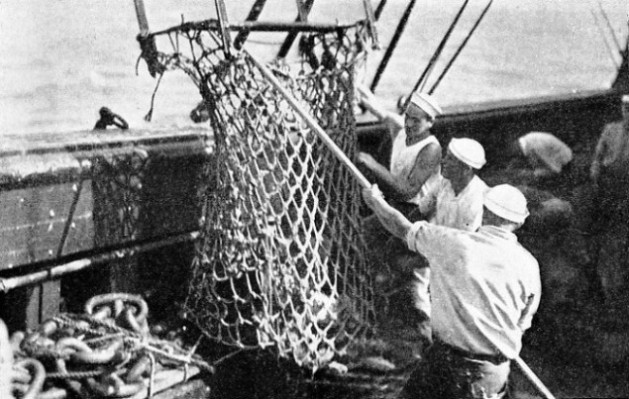
A ROPE SCALLOP DREDGE being hauled on board the Arcturus, the floating laboratory of the expedition commissioned by the New York Zoological Society. The Arcturus is a three-
THE exploration of the depths is all the more fascinating because of the difficulties which confront the men who seek to wrest its secrets from the sea. The waters themselves seem effectively to bar the intrusion of man.
The naked diver can explore the shallows and the diver in his flexible diving dress has managed by a supreme effort to reach 310 feet, yet even the record depth of 3,028 feet to which the American scientist Dr. Beebe descended in his strong steel globe known as the bathysphere falls far short of penetrating the greatest depths of the ocean. The average depth of the sea is 11,500 and more than half the area of the entire sea-
Frankly acknowledging the impossibility of reaching such depths, and at the same time being impelled by the desire to learn something about them, the scientist has pressed into his service all the inventive powers of the human mind. The scientist goes out fishing for knowledge. His fishing line may be six or seven miles long, made of the toughest steel. To its end he attaches the various inventions which are specially designed to solve the problems that most concern him.
The flat or moving surface of the sea which hides the sea-
Yet the physical features we know on land have their counterpart under the sea They are modified by the different conditions, for trees and grass cannot grow on the sea-
As it recedes from the continents the sea-
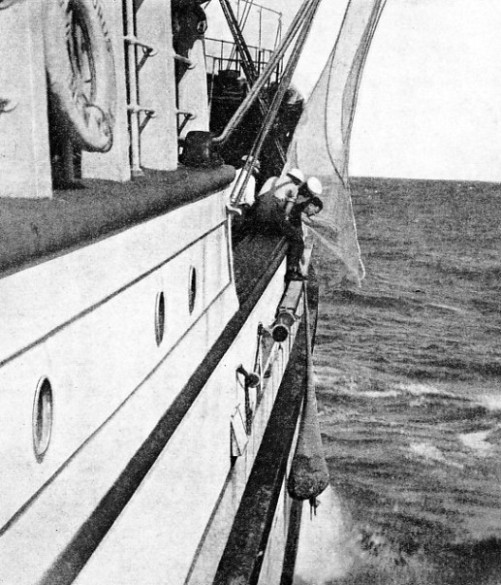
AN OTTER TRAWL being hauled on board the Arcturus with a '‘catch” from the sea-
In the same latitude, but about 850 miles to the east, a peak which approached to within 284 feet of the surface was discovered north of the Azores in 1850. It was named Mount Chaucer. Still farther to the east, at a distance of about 350 miles, the bed of the Atlantic heaps up to form the submarine mountains known as the King Edward VII Range. Another submarine peak, Mount Placentia, comes to within 30 feet of the surface.
These submarine mountains have all been revealed by sounding. As the sailors in the old days, when sailing through a channel, used to heave the lead to find out the depth of water under
the keel, so the discoverers of these ranges have heaved the lead to a depth of perhaps two or three miles. They note how much line they must pay out before they manage to touch bottom, and so they form a good idea of the contour of the sea-
The laying of the cables on the beds of the oceans greatly fostered the scientific study of the sea-
The Ladrone Basin, in which this huge depression was found, is itself from 18,000 to 24,000 feet deep. The Nero Deep, as the discovery was named, burrows down for another mile and a half to a depth of 31,614 feet. If it were possible to drop Mount Everest into this gigantic chasm, the world’s highest mountain (29,141 feet) would vanish beneath the waves and its top would be covered by nearly half a mile of water.
In earlier days, before modern sounding apparatus with all its refinements came into existence, it was the practice to obtain a sample of the sea-
If the scientist be merely concerned with learning the contour of the sea-
At the exact instant when the sound signal is made, a stylus begins to make a mark on the recording strip of paper, and it ceases to mark as soon as the echo is detected. The length of this mark indicates the length of time that the sound has taken to travel to and from the sea-
As the echo sounder can be set to work rapidly if desired, a continuous reading of the depth of the sea can be secured as the ship steams at speed. There are three or four types of this sounding apparatus made to operate at various depths down to the extreme depth of 36,000 feet. With this instrument the wreck of the Lusitania was located in 1935.
All the stuff carried down by the rivers, the decaying vegetation and mud, and the material eroded from the coasts by the waves — the never-
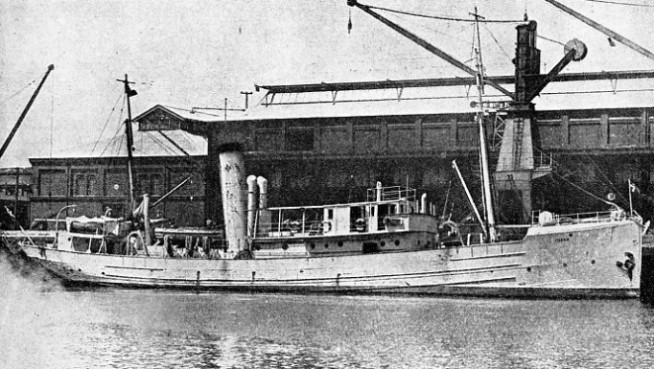
A DANISH SCIENTIFIC OCEAN RESEARCH SHIP, the Dana, set out in 1920 to make a comprehensive oceanographic survey during a voyage which lasted for two years. This photograph shows the Dana at Wellington, New Zealand. The expedition was led by Professor Johann Schmidt;
220 specimens of deep-
The greatest depths of all are covered with red clay. No form of life has ever been discovered in these abyssal depths. Occasionally a shark’s tooth belonging to an extinct species, or a hard bone from the head of a whale has been brought up, but nothing of an organic nature has ever been found. Long before the cells of any living creature could sink to these remote depths they are dissolved by the chemical action and by the pressure of the sea.
The nets which have been invented to enable the oceanographer to discover the various forms of life that exist in the lesser depths assume the most amazing shapes and sizes. Great trawl nets with gaping mouths are designed to drag along the bottom and collect the fish that swim in their path.
There are peculiar nets shaped in the same way as pyramids standing on their points, nets similar to long cylinders, others similar in shape to cones, square nets, triangular nets, other nets in a multitude of forms for a multitude of purposes. The meshes of the nets are made large or small to capture fish of various sizes. Some of the nets that go down to the inky depths have even been fitted with electric lights which serve to lure the fish inside them. Others are made of the finest silk to capture forms of life, mere specks of jelly, that cannot be seen by the naked eye.
Life in the Middle Depths
With these nets, and other inventions, some of the most fascinating secrets of the sea have been revealed, and every expedition that goes out adds something to our knowledge. The organic material carried down from the land is one of the main sources of food for fishes, so the fish population is always greater near the shores and shoals than far distant from the land. Plankton (minute animals and plants in the ocean) breeds in myriads on the surface of the sea and forms another main source of food for the fish. Fish are also given to preying on one another.
As hungry fish are always eating up the food that comes down from the land, and any food that escapes their maws will be liquefied before it reaches the depth of a mile, a number of clever men came to the conclusion that no fish could exist in the belt of sea known as the middle depths, because no food could be found there to sustain life. The theory was so logical that it was generally accepted. Even when it was reported that one or two fish had been discovered from a depth of about two miles, an air of scepticism still persisted.
This was the state of affairs when Prince Albert of Monaco, who devoted much of his time and wealth to the study of the sea, and whose Oceanographic Museum on the island of Monaco is one of the wonder-
He told no one of his project, but waited for an opportunity of testing the theory for himself. It came one evening when the Prince was at dinner.
Lieutenant Bouree rigged a net and sent it shooting down into the depths as the yacht continued on her course. Not until between two or three miles of line had run out did he stop the descent. By that time, having judged the angle at which the net was being towed, he knew his drag was down in the middle depths. During its descent it was kept closed so that no fish could get into it and confuse the issue as to the depth at which they had been caught. He now sent the “messenger” sliding down the cable. The “messenger” is a weight which strikes against a set of levers and thus opens the net.
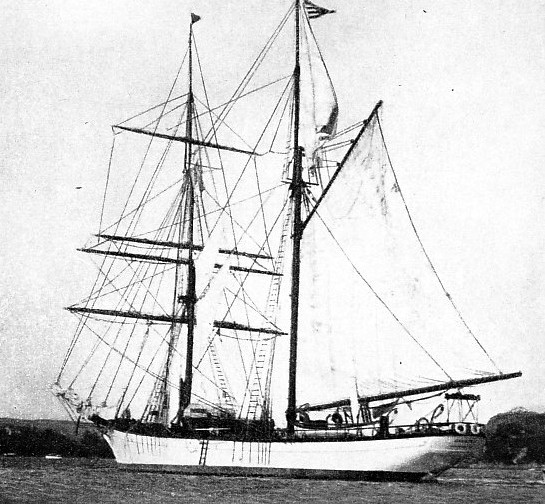
A NON-
For some hours the young officer waited and wondered what the net would reveal. After he had sent another “messenger” sliding down to close the net he set the engine to work winding it up. The net came from the water with fish visible through the meshes and the Prince of Monaco was called to see the fish that had been brought from the middle depths to confound all the theories.
Since then our knowledge of the forms of life inhabiting the middle depths has continued to expand. The sea down there is pitch black. Not even the faintest glimmer of a ray penetrates the belt of water, as was proved by sending down some highly sensitized photographic plates in a special camera made to withstand the pressure.
Upon arrival at the desired depth, the lens of the camera was opened, and the plate was exposed for hours before the camera was brought up. The plate was not in the least affected, and thus proved that the darkness down there is absolute. Every test made since then has confirmed this finding.
Scientists were rightly puzzled about the way fish could live and breed in this world of utter darkness where food was so scarce, and expedition followed expedition to try to solve the many problems involved. The difficulties of gathering evidence may be imagined when it is known that up to about 1920 only some seventy specimens of deep-
In 1920 the Dana expedition set out under the leadership of Professor Johann Schmidt to explore the depths of perpetual night in the Gulf of Panama and the North Atlantic. The little band of scientists that formed this Danish expedition steamed about their selected grounds for two years, shooting their nets to various levels, opening them, trawling for so many hours, then closing them and bringing them up.
Everything captured was noted, with the date of the catch, the length of line that was out and the time the net was down. The methods of the expedition were most thorough, and Professor Schmidt returned to port with the most important scientific set of specimens ever captured.
Among his 220 specimens from the lower depths were twenty entirely new and unknown fishes. These specimens were entrusted to Dr. C. Tate Regan, of the British Museum, for classification and examination.
It seems impossible that fish which are black in colour could ever find a mate swimming in that perpetually black sea. Such conditions appear to condemn the species to extinction. But Nature, in placing them in the depths, found her own solution to this difficult problem. When he examined some of these specimens, Dr. Tate Regan found what appeared to be tiny growths. Upon further investigation these proved to be male fishes that were permanently attached to the skin of the females.
This attachment must take place early in life, the mouth and tongue being completely fused to the skin and a complete set of blood vessels being formed through which the female nourishes the male. The minute male is thus a true parasite incapable of eating or digesting food; his sole function is to fertilize the eggs of the female, which carries him about with her through life. It is an extraordinary adaptation of Nature.
Just as wonderful are Nature’s ways of enabling the deep-
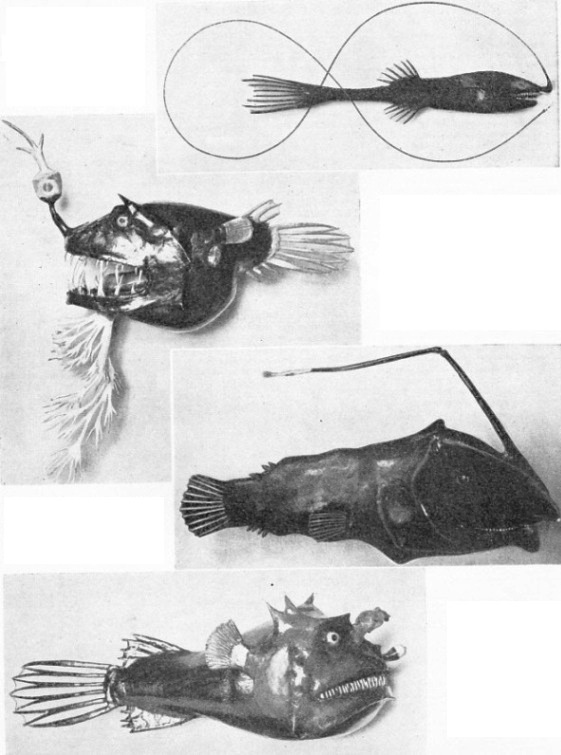 THE ANGLER FISH known as Gigantactis macronema is shown (top right) from a model made by A. Fraser-
THE ANGLER FISH known as Gigantactis macronema is shown (top right) from a model made by A. Fraser-
A BEARD RESEMBLING SEAWEED helps to disguise the Linophryne arborifer (top left) when lying in wait for a victim. The luminous projection from the snout, shining in the perpetual gloom, attracts the prey, and the angler’s jaws reveal themselves too late. This fish is only about three inches long.
A LUMINOUS LURE or bait is attached to the rod that extends from the snout of this strange deep-
A PARASITIC HUSBAND is attached to the forehead of the female Photocorynus spiniceps (bottom). The male has no separate existence but is a permanent parasitic incapable of eating or digesting food; his life is maintained through the blood vessels of the female and his sole function is to fertilize the eggs of the female. This photograph, as well as that of the Linophryne arborifer is from a model made by A. Fraser-
One fish has this luminous bait attached to a “fishing line” which is four times as long as itself. Other small fish, no more than two or three inches long have developed a remarkable disguise resembling seaweed, which hangs from their under jaws, while from their snouts project luminous bulbs surrounded by filaments on the end of a short rod. These little fellows conceal themselves in the mud or the crannies of rocks with their luminous bulbs shining in the darkness and their weedy disguise swaying with the movement of the sea until an inquisitive fish comes along to see what the light is, and the gaping jaws of the angler close on another meal.
In some of these fish the whole roof of the mouth is luminous. The fish simply opens its mouth and waits till another fish comes along and puts its head into the trap. Another fish has luminous eyes similar to the bull’s-
There are some fish whose bodies have a row of spots similar to port-
Instead of having lights on the tips of their noses, other little fish have luminous barbels or baits hanging from their lower jaws. Many of these fish have enormous mouths with great teeth set in rubber-
Fish at 19,800 Feet
Here is one of Nature’s masterpieces of practical design. In all probability its ancestors were fishing in the black depths long before man existed on the earth. The fact that the fish persists to this day is a living proof of the perfection of Nature’s design, for if the fishing rod and baits and hooks, with the big mouth that acts as a landing net, had not been effective, the species would have died out ages ago.
The greatest depth from which any fish has ever been taken is 19,800 feet. An expedition captured this fish off Cape Verde Islands and named it Grimaldichthys profundissimus. Most of the fish that come from the depths are black or dark in colour, and many of them have no scales at all, but have leathery skins.
The fish that swim in the upper waters are usually lighter underneath than on top, which is one of Nature’s ways of disguising them. The light shining from the surface casts a shadow beneath them, and if the fish were of a uniform colour above and below they would be made conspicuous by a density of colour on the underside. Just as the artist mixes black and white to make a grey tone, so Nature gives the fish a light underside to combine with the dark shadow and reduce the fish to a uniform colour as it swims in the sea.
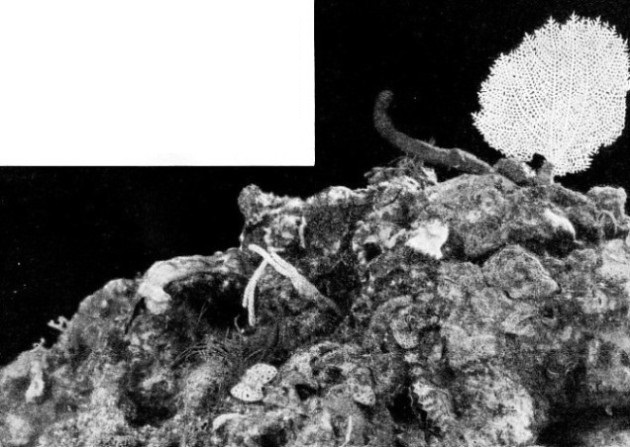
A SUBMARINE GARDEN on the Saba Bank in the Sargasso Sea. This photograph was taken by a member of the New York Zoological Society Expedition in the Arcturus, when Dr. William Beebe used his bathysphere, shown at the foot of this page.
Not content with black fish in a black sea, Nature has endowed other fish with the powers of invisibility by making them transparent. If they were swimming about under our eyes we could not see them because we would see right through them. But when these fish are brought up and die, they become more visible and lose some of their transparency. It is peculiar that although the deep-
Little piggy eyes set in deep sockets are characteristic of some deep-
As Dr. Beebe dropped down in the bathysphere off Bermuda, the colour of the sea changed from green to blue and then to grey and absolute blackness beyond 1,200 feet.
In the revealing beam of the searchlight which shone through the quartz window of the sphere he saw fish that have never yet been caught in nets. One of these fish, seen at 2,000 feet, was six feet long. It had whip-
Another new angler fish had three rods on the top of its body just behind the head with a yellow light on each. Some little fish which Dr. Beebe termed abyssal rainbow gars, formed a wonderful sight as they stood on their tails in a line, their heads and necks being scarlet, their bodies a bright blue and their tails yellow.
The Black Swallower
As the scientist observed these wonders, he telephoned a description of them to one of of his assistants who was stationed in the ship above and took down the words. Once or twice something approached the glass of the bathysphere and seemed to explode so violently that Dr. Beebe and his companion, Mr. Otis Barton, drew back from the windows. Then they were able to detect a vivid scarlet deep-
In one of his nets Dr. Beebe captured a black swallower, a fish between two and three inches long which somehow manages to swallow other fishes five and six inches long. The stomach of the black swallower stretches as if it were a balloon. The swallowed fish is coiled round until the meal is gradually absorbed in the way that a python will swallow and absorb a buck.
Dr. Beebe’s record descent of over half a mile in the bathysphere not only added to our knowledge of the ocean, and revealed several new varieties of fish, but it also gave the students of the middle depths another puzzle to solve. Because the fish drawn up from the depths were always so small it was reasoned that there was not enough food available in the depths to sustain fish with large bodies. Now the specimens of large fish seen by Dr. Beebe, fish that have never been netted, make the oceanographer wonder whether the theory is right or whether it may not be as mistaken as the idea that no fish at all could live in the middle depths.
Meanwhile, no man can say what new wonders the sea will reveal. This much is proved: the flowers of the earth are not more beautiful in their colours than the rainbow fish of the sea.

THE BATHYSPHERE, a strong steel globe used for descents to the sea-
You can read more on “Exploring the Ocean Depths”, “Man’s Conquest of the Depths” and
“Survey Ships at Work” on this website.